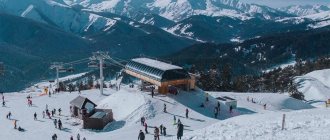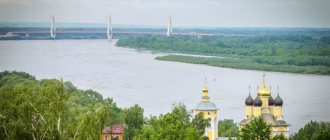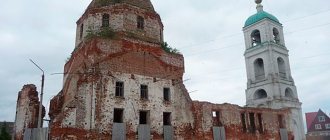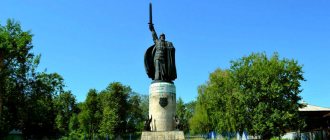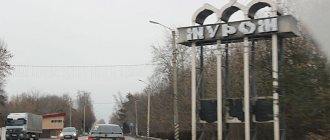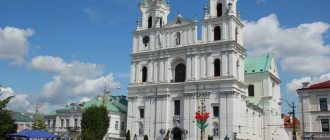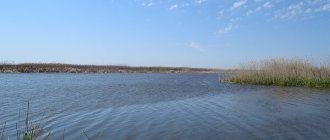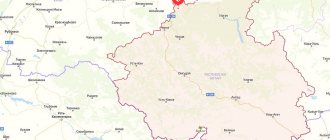The ancient city of Murom is located on the territory of the Vladimir region. The history of its existence is inextricably linked with the centuries-old history of Rus'. The city is located on the left bank of the Oka, which separates the modern Vladimir and Nizhny Novgorod regions. In the historical center of Murom there is a city park, on the edge of which there is a monument to the epic hero Ilya Muromets and an observation deck on the Oka River. Behind the wide riverbed, the opposite bank is clearly visible, gradually receding into the distance of the vast Russian land. As if guarding his native expanses, Ilya Muromets looks beyond the horizon. He raised his sword high, as if warning strangers to protect his native city and all of Rus'. Like many other settlements in our country, Murom is a small city in Russia. As of 2021, its population is just over 100 thousand people. Russian spirituality and legends associated with the centuries-old life of the city are honored here. To get in touch with the history of Rus', you need to walk along these quiet ancient streets of the central part of the city. Visit monasteries and temples, surprising with their incredible architecture, and mentally transport yourself to those turbulent years of the formation of Rus'.
History of Murom
Murom is one of the oldest cities in Rus'. It was first mentioned in the Tale of Bygone Years in 862 as one of the cities subject to Prince Rurik (830 - 879). This year, the Varangians were invited to Rus' under the leadership of Rurik, who became the Novgorod prince and founder of the ruling Rurik dynasty. Rurik's descendants ruled Rus' for more than seven centuries (until 1598). The dynasty ended with the death of Tsar Fyodor I Ivanovich (1557 - 1598, the middle son of Ivan the Terrible). Of course, before the arrival of Rurik and the beginning of his reign, Murom was already a city in which people lived for some time. It may have been quite a long time, but the year 862 is considered to be the year the city was founded. That is, the official history of Murom begins with the beginning of the history of the rule of the Rurikovichs.
After the death of Rurik in 879, the Prophetic Oleg (no data - 912) became the regent of his young son Igor (877 - 945). It unites the northern Novgorod Slavic lands and the southern Kievan Slavic lands into one large state of Kievan Rus. We can say that it is the Prophetic Oleg who is the founder of the Old Russian state. He moved to Kyiv and from 882 was called the Grand Duke of Kyiv. Thus, the Kiev princely throne becomes the main one in Rus'.
Over the years, the Rurik family expanded, and the great princes placed their relatives on the princely thrones of other Slavic cities. A “ladder” system of succession to the throne appeared. According to it, the princes did not have lifelong inheritances. All Rurikovichs were considered co-owners of the state. Power was transferred according to the principle of seniority in the family. With the accession of a new prince to the Kiev throne, all the other princes were moved. They moved from less important cities to more important ones. Murom also occupied a certain status in the established hierarchy.
Gleb Vladimirovich (990 – 1015, son of Vladimir Svyatoslavovich, nicknamed “Red Sun”, who baptized Rus' in 988) is considered the first prince of Murom. Gleb's life was very short. He reigned in Murom for only a couple of years. At the beginning of 1015, Prince Vladimir became very ill and called his beloved son Boris (986 - 1015) from Rostov, to whom he was going to transfer the Kiev throne. This violated the “Ladder” system of succession to the throne and caused the indignation of his other sons: Svyatopolk Vladimirovich (979 – 1019, who later received the nickname “Cursed”) and Yaroslav Vladimirovich (978 – 1054, who later received the nickname “Wise”). Yaroslav at that time was the Novgorod prince and occupied a higher position in status than the Rostov prince Boris. After all, Novgorod and the lands subordinate to it annually paid the largest contribution to the Kyiv treasury. Having learned about the decision of his father (Prince Vladimir) to give the Kiev throne to Boris, Yaroslav stopped paying the contribution. Vladimir himself was already sick and weak. He ordered Boris and the Kyiv squad to go to Novgorod and demand that Yaroslav submit to the will of the Grand Duke. But then suddenly news came about the Pecheneg invasion, and Boris was forced to meet them halfway. Having learned about the approach of the Russian army, the Pechenegs turned back.
At this time, Prince Vladimir died and Svyatopolk Vladimirovich did not fail to take advantage of the current situation. With the help of his supporters, he is freed from prison, where he had previously been imprisoned by Prince Vladimir, and seizes the Kiev throne. Returning with his squad back to Kyiv, Boris stops at the Alta River. Here a messenger arrived to him, who reported the death of his father and the seizure of the Kyiv throne by his half-brother Svyatopolk Vladimirovich. The squad offered to go to Kyiv and take the throne by force, but Boris did not want bloodshed. He refused to go against his brother. After this, the squad left him. Svyatopolk himself was afraid of Boris and sent his people, who mercilessly killed him.
Murom Prince Gleb Vladimirovich was very friendly with his blood brother Boris Vladimirovich. Svyatopolk Vladimirovich, not without reason, feared that as soon as Gleb learned about these events, he would rush to avenge his brother. Ahead of the rumors, Svyatopolk sent a messenger to Gleb with a request to come to Kyiv due to the poor condition of their father, Prince Vladimir (by that time he was already dead). Gleb naturally headed to Kyiv lightly, without a squad. At a parking lot near Smolensk, a messenger arrived to him from his brother Yaroslav. He spoke about the death of his father and the murder of his brother. In the message, Yaroslav dissuaded him from going to Kyiv. The news made an indelible impression on Gleb. He began to remember his father and brother in his prayers. After some time, messengers arrived from Svyatopolk, who without hesitation took the life of an innocent person.
Boris and Gleb did not fight against their half-brother Svyatopolk. They did not even oppose his seizure of the Kyiv throne, but were still killed. This is very sad and sad. Probably, it was such a difficult time back then and they stopped at nothing to achieve their goal. Boris and Gleb are considered the first Russian saints. The exact date of their canonization (canonization) has not yet been established. The most reliable date is considered to be 1072, when their relics were transferred to a new stone church.
Over the next few centuries, many princes changed in Murom. Some reigned for a long time, while others reigned for a very short time. And in 1392, the Grand Duke of Moscow Vasily I Dmitrievich (1371 - 1425, son of Dmitry Donskoy) annexed Murom to the Moscow principality.
Ilya Muromets
The city of Murom is famous for its epic hero Ilya Muromets. According to Russian legend, Ilya was originally from the village of Karacharovo, near Murom (now the village is a microdistrict of the city). He lay on the stove for three decades, “not having control” (could not move) his arms and legs. One fine day, “walking kaliki” (an ancient name for wanderers who sing spiritual poems and epics) entered his hut. They asked Ilya to drink plain water and healing occurred.
Rising from the stove and feeling unprecedented strength, Ilya went to his parents. Together with other village residents, they tried to clear the area behind the houses for vegetable gardens, uprooting the stumps of perennial oak trees. Things moved very slowly. With great difficulty, people managed to break the stumps into pieces and drag them out of the territory in pieces. Rolling up his sleeves, Ilya began to pull them out with his bare hands. His parents were only surprised at his strength and were glad that he had grown up to be a good housekeeper. But the joy did not last long. Ilya told his parents that the “passing Kaliki” asked him to go to Kyiv and stand up for the Russian land.
The hero accomplished many feats, which are conveyed in epics. Rus' is grateful to him for this. Whether the real Ilya Muromets was now unknown for certain. Around that time, there lived an Orthodox monk with the name Ilya Muromets (Ilya Pechersky, before his tonsure he had the nickname Chobotok). In 1988, an examination of his relics was carried out and it was established that he was a warrior. It is quite possible that the epic hero was not just invented, but copied from a real prototype, who at the end of his life became a monk and received the name Ilya Muromets. In Murom the Russian hero is honored and remembered. The Gushchin family is considered his descendants. Representatives of this genus are also not deprived of power. In the 19th century, one of them was even forbidden to participate in fist fights, since he could accidentally miscalculate the force of the blow and, through negligence, take the life of his opponent. In general, the Gushchina surname comes from the location of the houses, which in those distant times were located in the thicket (thickness) of the forest. Now everything has changed. These smooth, well-groomed streets and neatly painted private houses. On one of them hangs a sign with the inscription: “House of the Gushchins. According to legend, at this place stood the hut of the glorious hero Saint Ilya of Murom.”
Murom, Spaso-Preobrazhensky Monastery
Ilya Muromets was canonized in 1643. His relics currently rest in the Near Caves of the Kiev Pechersk Lavra. There is an inexhaustible flow of pilgrims who want to visit the caves and touch them. Part of the relics (the middle finger of the left hand) is located in the Transfiguration Monastery in the city of Murom. They are built into a life-size wooden replica of the saint.
Coat of arms
The coat of arms of Murom is presented in the form of a French shield. It is divided into two parts horizontally. At the bottom, in the blue field, there are three rolls. They symbolize a traditional food product. At the top is the coat of arms of the municipality of the city of Vladimir. It depicts a golden lion rearing up. The animal is located on a scarlet background. The creature holds a silver cross in its front right paw. On his head is an iron crown.
The artistic composition was approved by decision of the Council of People's Deputies of the district No. 338 of January 27, 2004.
Peter and Fevronia
Currently, Saints Peter and Fevronia are revered by Orthodox people for their family values. They are, as it were, a model of love, family and fidelity, which is especially important now. This is a very good example for young people who are starting their own families. Let's find out a little more about their life story. As such, the Murom prince with the name Peter is not mentioned in historical documents and chronicles. He is identified with Prince Davyd Yuryevich (no data - 1228), who reigned in Murom from 1205 to 1228. His wife was Princess Euphrosinia. At the end of their lives, they simultaneously took monastic vows. At the same time, David received a new name Peter. There is no information about the name of the wife after tonsure. In 1547, on the initiative of Metropolitan Macarius (1482 - 1563), the canonization of the prince and his wife as locally revered saints took place at the Moscow Local Council. In connection with these events, the writer Ermolai-Erasmus, who was also a monk, was commissioned to compile their hagiography (biography). Despite all the severity, Ermolai-Erasmus (Ermolai the Pregreshny) described this story in a more artistic style, using Murom oral traditions. The result was “The Tale of Peter and Fevronia of Murom.”
The plot of the story is very interesting. In those ancient times, Prince Pavel lived and a fiery serpent (an evil spirit, a mythological creature in Slavic legends) began to come to his wife. It was very difficult to recognize him, since he appeared in the image of the prince himself. No matter how hard the snake tried, he could not deceive the woman’s heart. The wife told her husband about these events. The prince understood that it would not be possible to defeat the snake in an ordinary battle and asked his wife to find out why he would die. To the question asked, the serpent answered: “... from Peter’s shoulder, from Agrikov’s sword.” The prince had a brother named Peter, who immediately agreed to kill the snake. But where can I find Agrikov’s sword? According to legend, it was forged by Agric, the son of King Herod. In Russian legends, this sword is identified with a treasure sword, which allows one to cut through any warrior’s armor. Before the events described, it was transported from Vladimir and hidden in one of the Murom temples. An angel appeared to Peter in the form of a boy and showed him where the sword was kept. Peter took the sword and went to his brother. After sharing the good news with him and showing him the sword, he decided to return home. Passing by the princess's room, Peter again heard his brother's voice and immediately realized that it was a snake in the guise of a prince. Suddenly bursting into the room, Peter killed the snake, which before death took on its real appearance. Dying, the serpent splashed Peter with blood from its wound.
No matter how strong Peter was, he became very ill (sick) after a while. His body was covered with ulcers that no one could cure. Once in a dream, Peter seemed to see that Fevronia could help him. She was a simple peasant girl from the Ryazan village of Laskovo. Her father was engaged in beekeeping (from the word “bort” - tree hollow. Extracting honey and wax from hives located in tree hollows). Peter clung to every opportunity to recover, even the most absurd. He sent a messenger to Fevronia with a request to help him. The girl agreed, but on one condition. After recovery, Peter will have to take her as his wife. The fact is that during the treatment process, the naked patient will need to be rubbed with ointments and steamed in a bathhouse. At that time, a girl and a man could only be alone in a bathhouse if they were spouses. Otherwise, no one will simply marry Fevronia after this.
Peter had only one desire to be cured. In this state, he could promise anything. Peter agreed with this condition, but Fevronia was not a stupid girl at all and understood that they were from different walks of life. Just in case, she played it safe and left one unhealed wound on her leg. Peter did not notice this and decided to say goodbye to Fevronia, generously rewarding her for her work. It’s not that Peter was a bad person, but the marriage of members of princely (or royal) families has always been a matter of state. Alliances of such people were concluded to strengthen principalities and countries. Peter simply could not take a simple peasant woman as his wife. He was very worried about this. After all, the girl was smart and pretty. During their short acquaintance, Peter really liked her.
Some more time passed, and the disease began to return. Peter again turned to Fevronia and asked for treatment. The girl accepted her situation and completely cured the patient. Despite all the obstacles, Peter took Fevronia as his wife. Their family happiness was built on love, mutual respect and trust in each other.
After some time, the prince dies and Peter takes his place. The nobility immediately rebelled. She did not want to tolerate the princess being a former peasant. Things got to the point that the nobles put forward a condition to Peter: “Either let go of your wife, who offends us all with her origin, or leave Murom.” The prince took Fevronia and sailed along the Oka on two ships. Not even a few days had passed before they rushed to catch up with them, as unrest began in Murom. Everyone wanted to take the princely throne. In response to requests, Peter and Fevronia returned. They lived their lives happily, and before their death they took monastic vows and died on the same day.
Centuries have passed since then, and Peter and Fevronia (before the tonsure of David and Euphrosyne) are to this day a model of a family. Overcoming all difficulties, they created a good family union, which was based on love and respect for each other. Some modern people who are skeptical about Peter and Fevronia sometimes argue that they did not have children. Indeed, this moment is simply not reflected in “The Tale of Peter and Fevronia of Murom,” but in life Davyd Yuryevich and Efrosinia had two sons and a daughter.
Murom during the Great Patriotic War
During the Great Patriotic War (1941 - 1945), Murom was a rear city. Its streets were not touched by the boots of the conqueror, but the city made its contribution to the victory over the enemy. Many residents of Murom went to the front and remained on the battlefields. Those who were on the labor front forged victory in the rear. City enterprises tried to provide the Red Army with everything they needed. The railway workers of the Murom junction gave a gift to the front - an armored train. It was created by “the whole world.” In their free time from their main work, the workers of the carriage depot made armored platforms. There were four of them in the armored train (two closed, with two turrets from a T-34 tank each, and two open with anti-aircraft guns and M-8-24 multiple launch rocket systems). Foundry workers from Kulebak supplied the required amount of armor, which was manufactured at the Murom plant named after F.E. Dzerzhinsky. a reservation has been made. The result was a very good armored train.
Murom, monument to the armored train Ilya Muromets
The people who made it decided to give the armored train the name of the legendary hero Ilya Muromets. The workers' joy was very short-lived. Colonel Neplyuev, who arrived to pick up the armored train, wanted to call it “For the Motherland,” but no one did this. On February 8, 1942, a rally was held to mark the departure of the armored train to the front. Those gathered saw the inscription “Ilya Muromets” on its board. This moment greatly angered the officer. The inscription was ordered to be erased, but in many documents and in the minds of people he remained as Ilya Muromets. Subsequently, this name stuck with him.
The armored train Ilya Muromets was included in the 31st separate special division of armored trains. It was called special precisely because it was armed with rocket artillery (M-8-24). When Ilya Muromets was included in the division, the armored train was assigned serial number 2. In addition to him, the 31st division already had the armored train Kozma Minin at No. 1. To resolve staff and economic issues, the division had a special train, which included service cars (headquarters, first-aid post, workshop, kitchen, bathhouse and several residential ones). The division's vehicle fleet consisted of two BA-20 armored vehicles, three M-72 and IZH-9 motorcycles, six GAZ-AA trucks, two M-1 passenger cars and two GAZ-64 all-wheel drive vehicles.
31 armored train divisions were in the active army from May 1942 to May 9, 1945. At the end of 1942, the head of the main armored department issued an order dated December 05, 1942, on the basis of which the armored trains received new numbers (armored train No. 1 Kozma Minin received No. 659, and armored train No. 2 Ilya Muromets received No. 702). During these three long war years, the division covered the battle route from the Volga to the Oder and destroyed a large amount of enemy manpower and military equipment.
In June 1944, near Kovel there was a battle between the armored train Ilya Muromets and a German armored train. This is a rare case during the Great Patriotic War. Usually armored trains did not engage in open combat with each other. Here the German armored train brought a lot of problems to the Red Army troops. The Germans used it as a permanent mobile artillery battery. He drove out, fired several volleys and quickly drove back. Our command decided to destroy the German armored train as soon as possible. One day, Ilya Muromets positioned himself as close as possible to the expected line of action of a German armored train. Soon observers from Ilya Muromets noticed smoke, and the commander gave the command to fire a salvo. The German armored train also saw the danger, but in a hurry, the fire from its batteries turned out to be not so accurate. The final point in this battle was set by rockets fired from the Ilya Muromets armored train. After the liberation of Kovel, soldiers of the 31st division visited a broken German armored train. While examining it, one of the fighters noticed a train cover lying nearby. One half of it was damaged in battle and it was impossible to read anything, and on the other half it was written “Adolf Hitler...”. They immediately assumed that the German armored train was called “Adolf Hitler”. A young correspondent of one of the military newspapers came to look at the previously formidable military equipment, now lying like a defeated beast. It seemed symbolic to Hume that Ilya Muromets defeated Adolf Hitler. To inspire our soldiers at the front, an article with this loud title was written. Unfortunately, everything was not so pathetic. No documents were found confirming that the name of the German armored train was named after Chancellor of the Third Reich Adolf Hitler. This does not diminish the feat of the soldiers of the Ilya Muromets armored train. They defeated the German armored train, but what name it had was not so important to them. Let historians sort this out.
In 1971, a monument was erected in Murom in honor of the armored train Ilya Muromets. It is a real-size copy of an armored steam locomotive, almost identical to the original. Nearby there is a memorial plaque, which marks the combat path of the armored train in the Great Patriotic War.
Map
| Murom: maps |
Murom: photo from space (Google Maps) Murom: photo from space (Microsoft Virtual Earth)
| Moore. Nearest cities. Distances in km. on the map (in brackets along roads) + direction. Using the hyperlink in the distance , you can get the route (information courtesy of the AutoTransInfo website) | |||
| 1 | Navashino | 11 (16) | IN |
| 2 | Doschatoe (Nizhny Novgorod region) | 19 () | YU |
| 3 | Vyksa | 29 (42) | YU |
| 4 | Kulebaki | 34 (46) | SE |
| 5 | Melenki | 36 (41) | SW |
| 6 | Red Gorbatka | 37 (72) | NW |
| 7 | Vacha (Nizhny Novgorod region) | 53 (58) | NE |
| 8 | Nikologory | 63 () | WITH |
| 9 | Gremyachevo (Nizhny Novgorod region) | 65 (83) | IN |
| 10 | Sosnovskoye (Nizhny Novgorod region) | 75 (104) | IN |
| 11 | Vyazniki | 75 (115) | WITH |
| 12 | Ardatov (Nizhny Novgorod region) | 76 (109) | SE |
| 13 | Pavlovo | 77 (87) | NE |
| 14 | Tumbotino (Nizhny Novgorod region) | 78 (94) | NE |
| 15 | Kasimov | 81 (90) | SW |
| 16 | Gorokhovets | 81 (95) | NE |
| 17 | Sudogda | 84 (93) | NW |
| 18 | Voznesenskoye (Nizhny Novgorod region) | 87 (121) | SE |
| 19 | Gus-Khrustalny | 87 (142) | Z |
| 20 | Vorsma | 89 (100) | NE |
| 21 | Melekhovo | 89 (138) | NW |
| 22 | Gorbatov | 90 (116) | NE |
| 23 | Mstera | 90 (136) | WITH |
| 24 | Ermish (Ryazan region) | 90 (157) | YU |
| 25 | Kurlovo | 90 (163) | Z |
| 26 | Ilyinogorsk (Nizhny Novgorod region) | 94 (118) | NE |
| 27 | Diveevo (Nizhny Novgorod region) | 96 (139) | SE |
| 28 | Tengushevo (Republic of Mordovia) | 98 (139) | SE |
| 29 | Kovrov | 99 (149) | NW |
| 30 | Novosmolinsky (Nizhny Novgorod region) | 101 () | NE |
| 31 | Mulino (Nizhny Novgorod region) | 101 () | NE |
a brief description of
Located in the northeastern part of the Oksko-Tsninsky shaft, on the river. Oka (pier), 137 km southeast of Vladimir. Railway junction lines.
In 1970, Murom was included in the list of historical cities of Russia. The urban planning value of his heritage is assessed at a national level. In 2010, it was excluded from the list of historical cities.
Territory (sq. km): 77
Information about the city of Murom on the Russian Wikipedia site
Historical sketch
It was first mentioned in the Laurentian Chronicle in 862. Since 1097 it has been the capital of the Murom-Ryazan principality. In the middle of the 12th - early 15th centuries. - Principality of Murom. The name is associated with the Finno-Ugric tribe Muroma.
In 1088 it was devastated by the Volga-Kama Bulgars. In 1239, 1281 and 1293. - Mongol-Tatars. It was abandoned in 1293 and was restored in 1351.
At the beginning of the 15th century. became part of the Moscow Principality and was its eastern outpost.
In the 17th century important craft center. Leatherworking, shoemaking, furriery, blacksmithing, jewelry and other crafts existed here.
Since 1708, the city of the Kazan province. Since 1719, as part of the Vladimir province of the Moscow province. Since 1778, the district town of the Vladimir governorship (since 1796 - Vladimir province).
In 1856, in the district town of Murom, Vladimir province, there were 18 churches, 1,115 houses, 117 shops.
In the 18th century manufacturing enterprises developed in the 19th century. there were mechanical and iron foundries, flax spinning and cotton factories, etc. In 1916, a railway was built. workshops. The main occupation of the townspeople was gardening and horticulture.
In 1997, the working village of Verbovsky was included in the boundaries of Murom (PGT since 1943; 4.7 thousand inhabitants, 1959; 8.5 thousand inhabitants, 1970; 14.2 thousand inhabitants, 1979; 18.6 thousand inhabitants, 1989) .
Municipal indicators
| Index | 1999 | 2001 | 2003 | 2005 | 2006 | 2007 |
| Demography | ||||||
| Number of births, per 1000 population | 6.4 | 7.2 | 8.2 | 8.3 | 8.7 | 8.7 |
| Number of deaths, per 1000 population | 14.3 | 15.6 | 18.1 | 18.8 | 17.8 | 17.0 |
| Natural increase (decrease), per 1000 population | -7.9 | -8.4 | -9.9 | -10.5 | -9.1 | -8.3 |
| Standard of living of the population and social sphere | ||||||
| Average monthly nominal accrued wages, rub. | 964.6 | 2040 | 3586 | 5720.1 | 7042.5 | 8967.8 |
| Average housing area per inhabitant (at the end of the year), sq.m. | 17.5 | 18.1 | 20.2 | 20.9 | 21.3 | 21.7 |
| Number of preschool institutions, pcs. | 36 | 33 | 32 | 32 | 36 | 37 |
| Number of children in preschool institutions, thousand people | 4.3 | 4.4 | 4.4 | 4.7 | 5.1 | 5.3 |
| Enrollment of children in preschool educational institutions (at the end of the year), as a percentage of the number of children of the corresponding age, % | 82.8 | 85.7 | 78.6 | 80.9 | ||
| Number of daytime educational institutions (at the beginning of the school year), pcs. | 23 | 23 | 23 | 23 | 25 | 24 |
| Number of students in daytime educational institutions, thousand people | 17.7 | 16.1 | 14.3 | 12.1 | 11.7 | 11.2 |
| Number of doctors, people. | 441 | 423 | 408 | 409 | 406 | |
| Number of nursing staff, people. | 1447 | 1420 | 1419 | 1417 | 1396 | |
| Number of hospital institutions, pcs. | 8 | 8 | 8 | 8 | 7 | |
| Number of hospital beds, thousand units | 1.4 | 1.4 | 1.3 | 1.2 | 1.1 | |
| Number of medical outpatient clinics, pcs. | 14 | 14 | 16 | 19 | 17 | |
| Capacity of medical outpatient clinics, visits per shift, thousand units. | 5.4 | 5.5 | 5.9 | 6.1 | 5.9 | |
| Economy, industry | ||||||
| Number of enterprises and organizations (at the end of the year), pcs. | 1103 | 1236 | 1509 | 1507 | 1676 | 1753 |
| Number of operating enterprises by type of activity: mining (at the end of the year), pcs. | 1 | 1 | 1 | |||
| Number of operating enterprises by type of activity: manufacturing (at the end of the year), pcs. | 125 | 123 | 120 | |||
| Number of operating enterprises by type of activity production and distribution of electricity, gas and water (at the end of the year), pcs. | 37 | 38 | 36 | |||
| Volume of shipped goods of own production by type of mining (in actual prices), million rubles. | 8.9 | |||||
| Volume of shipped goods of own production by type of manufacturing (in actual prices), million rubles. | 7029.6 | 7144.0 | 9842.1 | |||
| Volume of shipped goods of own production by type of production and distribution of electricity, gas and water (in actual current prices), million rubles. | 562.3 | 692.1 | 718.9 | |||
| Construction | ||||||
| Volume of work performed by type of activity “Construction” (until 2004 - volume of work performed under construction contracts), million rubles. | 108.4 | 201.1 | 162 | 53.7 | 177.7 | 472.1 |
| Commissioning of residential buildings, thousand sq.m. of total area | 25.8 | 27.5 | 19.4 | 9.0 | 18.1 | 20.2 |
| Commissioning of residential buildings, apartments | 456 | 482 | 349 | 101 | 239 | 157 |
| Commissioning of preschool institutions, places | 0 | 0 | 0 | 0 | 0 | 0 |
| Commissioning of educational institutions, places | 0 | 0 | 0 | 0 | 0 | 0 |
| Commissioning of hospital facilities, beds | 0 | 0 | 0 | 0 | 0 | 100 |
| Commissioning of outpatient clinics, visits per shift | 0 | 0 | 0 | 0 | 0 | 150 |
| Transport | ||||||
| Number of bus routes (in intracity traffic), pcs. | 13 | 13 | 13 | 14 | 16 | 18 |
| Number of trolleybus routes, pcs. | 0 | 0 | 0 | 0 | ||
| Number of passengers transported by buses per year (in intracity traffic), million people. | 18.6 | 18.8 | 18.8 | 7.1 | 6.1 | 4.1 |
| Number of passengers transported by trolleybuses per year, million people. | 0 | 0 | 0 | |||
| Connection | ||||||
| Number of residential telephone sets of the city public telephone network, thousand units. | 20.8 | 21 | 24.3 | 25.3 | 25.3 | 25.4 |
| Number of payphones of the city telephone network (including universal ones), pcs. | 105 | 102 | 100 | 21 | ||
| Trade and services to the population | ||||||
| Retail trade turnover (in actual prices), million rubles. | 1285.6 | 1791.9 | 2446.2 | 3702.6 | 4955.5 | 6776.6 |
| Retail trade turnover (in actual prices), per capita, rub. | 9003 | 12735 | 19445 | 30127 | 40820 | 56425 |
| Index of physical volume of retail trade turnover, % compared to the previous year | 108 | 112.9 | 125.6 | 127.2 | ||
| Public catering turnover (in actual prices), million rubles. | 46.4 | 67.6 | 96.1 | 126.1 | 184.1 | 257.8 |
| Index of physical volume of public catering turnover, % compared to the previous year | 104.3 | 101.4 | 134.1 | 121.6 | ||
| Number of stores, pavilions (at the end of the year), pcs. | 99 | 72 | 86 | |||
| Sales area of shops, pavilions (at the end of the year), sq.m. | 9521 | 6227 | 9911 | |||
| Volume of paid services to the population (in actual prices), million rubles. | 113.2 | 379.3 | 721.7 | 1050.1 | 1281.8 | 1159.6 |
| Volume of paid services to the population (in actual prices), per capita, rub. | 792.5 | 2695.9 | 5737.1 | 8544.2 | 10558.4 | 9655.3 |
| Volume of household services to the population (in actual prices), million rubles. | 9.3 | 17.4 | 14 | 33.7 | 29.5 | 32.9 |
| Volume of household services to the population (in actual prices), per capita, rub. | 65.3 | 123.4 | 111.2 | 274.4 | 243.0 | 274.1 |
| Investments | ||||||
| Investments in fixed assets (in actual prices), million rubles. | 112.8 | 190.5 | 253.2 | 485.5 | 789.9 | 829.8 |
| Share of investments in fixed assets financed from budgetary funds in the total volume of investments, % | 15.3 | 15.7 | 36.9 | 19.5 | 37.1 | 41.4 |
Data sources:
- Regions of Russia. Basic socio-economic indicators of cities. Rosstat. - M:, 2008. pp. 27-28
- Regions of Russia. Main characteristics of the constituent entities of the Russian Federation: statistical collection. Goskomstat of Russia. - M:, 2003.
- Regions of Russia. Volume 1. Statistical collection. Goskomstat of Russia. - M:, 2001. p. 37
- Regions of Russia. Basic socio-economic indicators of cities. Statistical collection. Rosstat. - M:, 2005. p. 27
- Regions of Russia. Basic socio-economic indicators of cities. 2006. Statistical collection. Rosstat. - M:, 2006. p. 27
Culture, science, education
Branch of the Vladimir Polytechnic Institute.
Museum of Local Lore.
Memorial House-Museum of Academician of Painting I.S. Kulikova (native of Murom). The founder of Russian petroleum geology, Academician I.M., was born in Murom. Gubkin.
Universities of the city
Moscow Psychological and Social Institute (Murom branch)
602250, Vladimir region, Murom, Kuibysheva st., 30-b
Murom Institute (branch) of Vladimir State University
602264, Vladimir region, Murom, st. Orlovskaya, 23 WWW: https://www.mivlgu.ru/
Museums, galleries, exhibition halls
Cyber Museum in the city of Murom 602266, Vladimir region, Murom, st.
Klenovaya, 34 Phone(s) Website: https://mkt.izmuroma.ru/ Murom History and Art Museum 602267, Vladimir region, Murom, st. Pervomaiskaya, 4 Phone(s): (49234) 3-3152 Website: https://www.museum-murom.ru/
Architecture, sights
The old part of Murom is located near the cliff of the left bank of the Oka. In 1788, a regular layout was approved with straight streets built primarily with two-story houses with mezzanines according to “model designs.”
Spassky Monastery (founded in the 11th century), with the Transfiguration Cathedral (second half of the 16th century, rebuilt). Nearby is the small church of Cosmas and Damian (1565). Not far from it is the “new” church of Cosmas and Damian (1804; classicism) with a bell tower (1838).
In the center of the city is the Trinity Monastery (17th century) with the five-domed Trinity Cathedral (1642-43), the gate-roofed Kazan Church (1648), the bell tower (1652), and the fence (1807-08). Nearby is the Annunciation Monastery with the cathedral (rebuilt in the 17th century from the cathedral of the 16th century) and the gate church (1716, rebuilt in 1836).
On the edge of the coastal cliff is the Church of St. Nicholas of the Naberezhny (1700-17) with a refectory and a bell tower (1803).
Railway station in Art Nouveau style (1912, architect A.V. Shchusev).
| Population by year (thousands of inhabitants) | |||||||
| 1856 | 10.8 | 1970 | 98.8 | 2000 | 142.4 | 2013 | 112.6 |
| 1897 | 13.3 | 1973 | 105 | 2001 | 141.3 | 2014 | 111.5 |
| 1913 | 16.5 | 1976 | 110 | 2003 | 126.9 | 2015 | 110.7 |
| 1923 | 18.1 | 1979 | 114.3 | 2005 | 123.6 | 2016 | 110.1 |
| 1926 | 24.3 | 1982 | 118 | 2006 | 122.1 | 2017 | 109.8 |
| 1931 | 26.8 | 1986 | 122 | 2007 | 120.8 | 2018 | 109.1 |
| 1939 | 40.1 | 1989 | 124.2 | 2008 | 119.4 | 2019 | 108.1 |
| 1959 | 71.6 | 1992 | 126.5 | 2010 | 117.0 | 2020 | 107.0 |
| 1962 | 83 | 1996 | 126 | 2011 | 116.1 | 2021 | 105.6 |
| 1967 | 96 | 1998 | 144.0 | 2012 | 114.0 | ||
Literature
- Krogius V.R.
Historical cities of Russia as a phenomenon of its cultural heritage. M.: Progress-Tradition, 2009. p. 237 - Pospelov E.M.
Geographical names of the world: Toponymic dictionary: About 5000 units. M.: Russian dictionaries, Astrel Publishing House LLC, AST Publishing House LLC, 2001. p. 278 - Ch.
ed. Gorkin A.P. Geography of Russia: encyclopedic dictionary. M.: Great Russian Encyclopedia, 1998. p. 382 - Ch.
ed. Lappo G.M. Cities of Russia: encyclopedia. M.: Great Russian Encyclopedia, 1994. pp. 285-286
Murom today
Currently, Murom is one of many small towns in Russia, but its age allows the city to take its rightful place in the history of the state. Many tourists come here who want to see these ancient places with their own eyes. Wonderful excursions are held in Murom, and Orthodox pilgrims are sure to visit its monasteries. After all, the relics of Peter and Fevronia are kept here, as well as part of the relics of Ilya Muromets. This is a quiet and peaceful city where good people are always welcome. If visiting Murom is associated with good intentions, then here you will be greeted as if you were one of the city’s native residents.
City information
Murom is the administrative center of the city district and district of the same name. It is located in the west of the Russian Federation in the Vladimir region, on the left bank of the Oka River. The economy is represented by machine-, instrument-making, woodworking, and light industry enterprises.
The P72 and P125 highways pass through the settlement. There is a line of the Gorky Railway. River communication is poorly developed. There are universities and their branches, professional and secondary specialized educational institutions. There are cultural and art institutions. It is a favorite destination for many tourists.
